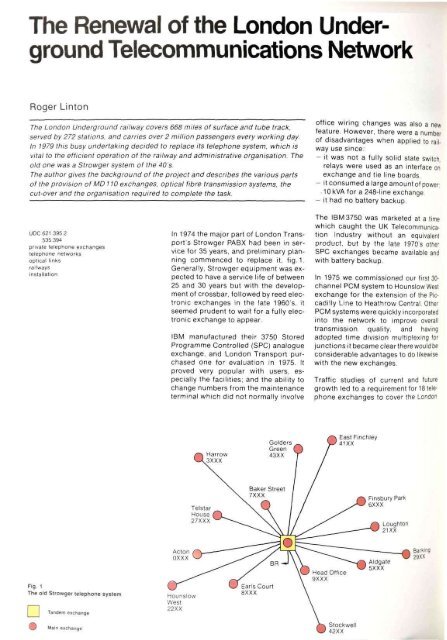Field Trial of Optical Fibre Cable-TV System Optical Fibre System for ...
Field Trial of Optical Fibre Cable-TV System Optical Fibre System for ...
Field Trial of Optical Fibre Cable-TV System Optical Fibre System for ...
Create successful ePaper yourself
Turn your PDF publications into a flip-book with our unique Google optimized e-Paper software.
The Renewal <strong>of</strong> the London Underground<br />
Telecommunications Network<br />
Roger Linton<br />
The London Underground railway covers 668 miles <strong>of</strong> surface and tube track,<br />
served by 272 stations, and carries over 2 million passengers every working day.<br />
In 1979 this busy undertaking decided to replace its telephone system, which is<br />
vital to the efficient operation <strong>of</strong> the railway and administrative organisation. The<br />
old one was a Strowger system <strong>of</strong> the 40s.<br />
The author gives the background <strong>of</strong> the project and describes the various parts<br />
<strong>of</strong> the provision <strong>of</strong> MD110 exchanges, optical fibre transmission systems, the<br />
cut-over and the organisation required to complete the task.<br />
<strong>of</strong>fice wiring changes was also a new<br />
feature. However, there were a number<br />
<strong>of</strong> disadvantages when applied to railway<br />
use since:<br />
- it was not a fully solid state switch,<br />
relays were used as an interface on<br />
exchange and tie line boards.<br />
- it consumed a large amount <strong>of</strong> power:<br />
10 kVA <strong>for</strong> a 248-line exchange.<br />
- it had no battery backup.<br />
UDC 621.395.2<br />
535.394<br />
private telephone exchanges<br />
telephone networks<br />
optical links<br />
railways<br />
installation<br />
In 1974 the major part <strong>of</strong> London Transport's<br />
Strowger PABX had been in service<br />
<strong>for</strong> 35 years, and preliminary planning<br />
commenced to replace it, fig. 1.<br />
Generally, Strowger equipment was expected<br />
to have a service life <strong>of</strong> between<br />
25 and 30 years but with the development<br />
<strong>of</strong> crossbar, followed by reed electronic<br />
exchanges in the late 1960s, it<br />
seemed prudent to wait <strong>for</strong> a fully electronic<br />
exchange to appear.<br />
IBM manufactured their 3750 Stored<br />
Programme Controlled (SPC) analogue<br />
exchange, and London Transport purchased<br />
one <strong>for</strong> evaluation in 1975. It<br />
proved very popular with users, especially<br />
the facilities; and the ability to<br />
change numbers from the maintenance<br />
terminal which did not normally involve<br />
The IBM 3750 was marketed at a time<br />
which caught the UK Telecommunication<br />
Industry without an equivalent<br />
product, but by the late 1970s other<br />
SPC exchanges became available and<br />
with battery backup.<br />
In 1975 we commissioned our first 30-<br />
channel PCM system to Hounslow West<br />
exchange <strong>for</strong> the extension <strong>of</strong> the Piccadilly<br />
Line to Heathrow Central. Other<br />
PCM systems were quickly incorporated<br />
into the network to improve overall<br />
transmission quality, and having<br />
adopted time division multiplexing <strong>for</strong><br />
junctions it became clearthere would be<br />
considerable advantages to do likewise<br />
with the new exchanges.<br />
Traffic studies <strong>of</strong> current and future<br />
growth led to a requirement <strong>for</strong> 18 telephone<br />
exchanges to cover the London<br />
East Finchley<br />
41XX<br />
Finsbury Park<br />
6XXX<br />
Barking<br />
29XX<br />
Fig. 1<br />
The old Strowger telephone system<br />
Tandem exchange<br />
Hounslow<br />
West<br />
22XX<br />
^P<br />
Main exchange<br />
Stockwell<br />
42XX
















